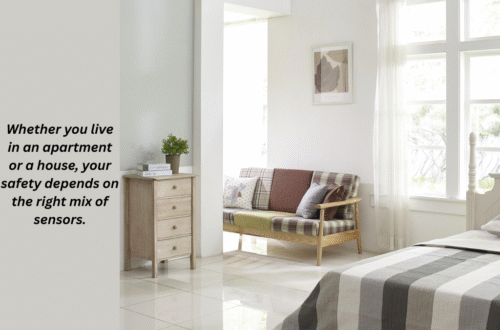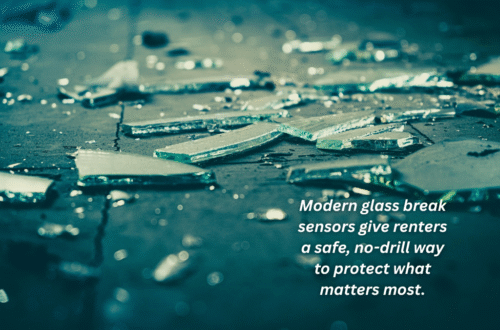
Are Glass Break Sensors Worth It for Apartments?
Renters, especially those living on ground floors or with balcony access, are always at risk of intruders. They enter through the windows or sliding glass doors. There is an exception to using bulletproof glasses. However, this solution is neither affordable nor practical ffull-wiredor renters. The next option is installing a motion sensor. It’s true that motion sensors actively secure your property, but you have to deactivate them around kids, pets, and guests.
If you opt for installing a traditional door sensor, then remember that they cannot detect an entry through windows. In contrast to all these scenarios, a glass break sensor immediately alerts you the moment the glass is shattered.
Unlike homeowners, renters can’t always install full wired security systems. Most rely on DIY smart devices. Glass break sensors fill an important security gap in these setups by catching forced entries that other devices might miss.
These sensors provide an extra layer of protection, especially if you have
- You have ground-floor windows
- The layout of your house exposes glass surfaces that are easy targets.
- Sliding glass doors
- Windows as potential entry points
- Pets that might trigger motion sensors falsely, so glass break sensors offer detection without depending on motion through space
- You live in a higher crime area, especially if forced glass entry is a known risk.
Check out the Top 5 Glass Break Sensors for Renters
How a Glass-Break Sensor Works?
Glass break sensors are designed to send an alert when someone breaks the glass window or a glass door in your home. Depending on the type of sensors you use, it may cover the entire room or have to be installed at each window. If you have connected your security system to your smartphone, then you will receive that alert, wherever you are. Some systems can also trigger video recording or notify monitoring services to contact emergency responders if the sensor is triggered. Here’s how a glass break sensor works:
- They use an audio detection mechanism to listen for sounds, for example, glass shattering.
- Some sensors also use vibration, shock, and acceleration sensors to detect physical disturbances to the glass. For example, they can detect if somebody presses, taps, or shakes the glass. These movements don’t have audio, but they do have a vibration effect.
There are two main categories of glass-break detectors:
Acoustic (Sound-Based) Sensors
These sensors “listen” for sounds typical of glass breaking. A single acoustic detector may cover multiple windows in a small room.
- Basic models are tuned to the specific frequencies that glass emits when breaking.
- Advanced ones operate in two stages: first listening for loud sounds, then analyzing whether the sound matches known glass-breaking profiles. This staged process helps save battery life.
Shock (Vibration-Based) Detectors
These are mounted directly on the glass. Instead of listening, they detect vibrations of both hard and soft materials. This also includes the movement of the glass itself.
The vibration-based detectors contain a wire attached to the glass. When the glass moves, the wire senses it and triggers an alert. Because they detect vibrations, even a strong knock might trigger them (depending on sensitivity).
Benefits of Glass Break Sensors for your Apartment
- Early detection can alert you before an intruder fully enters
- Extra security because window contact sensors alert when a window is opened or lifted, but they won’t detect broken glass.
- Comprehensive coverage because they can cover many windows, even those you might not be actively watching
- A deterrent effect that discourages intruders from avoiding homes that appear well-protected
- Glass break sensors offer proactive alerts. Motion sensors alert only when an intruder is already inside. While glass-break sensors can detect a break-in attempt earlier.
- Minimal false alarms
- Integration with broader security systems
Disadvantages
- Acoustic sensors might trigger from loud sounds like glass rattling or a dropped object; shock sensors might react to slamming doors.
- Shock sensors generally require installation on each pane of glass.
- Acoustic detectors may not detect silent methods of glass cutting, and shock sensors may not trigger if the glass isn’t moved.
- In smaller homes, you might naturally hear glass breaking. In such cases, the extra sensor might be redundant.
Limitations of Glass Break Sensors
- They should not be the sole or primary security measure. They are best used as a supplement.
- False alarms are possible, especially if minimal noise or vibrations interfere.
- Some types of glass may not break or transmit the expected signals reliably. This makes detection harder.
- The ambient noise environment, materials around the window, and proper placement are all important for effectiveness.
Do You Need Glass-Break Sensors?
Not every property requires them. For example, upstairs windows might already be out of reach, making them less of a target. But for ground-floor windows or accessible glass doors, they can provide worthwhile protection.
- For acoustic sensors, typically, one per ground-level room may suffice, depending on room size.
- For shock detectors, one is needed for each window or glass door.
Choosing the Right Sensor
When selecting a glass-break sensor, consider:
- Good acoustic sensors cover 20-25 feet in all directions.
- You want enough sensitivity to detect breaking glass. But you do not want these sensors to get triggered by the normal voice.
- More sophisticated sensors can better distinguish real threats from false alarms.
- Make sure that the detector works with your current security setup.
- Choose models that send information to your phone.
- If you use Alexa, Google, or other platforms, make sure the sensor integrates with them.
- Glass-break detectors usually cost between $ 35 and $ 70. The prices may decrease during sales.
Installation and Maintenance
Placement Tips
- Acoustic sensors should be placed within 20 feet of the windows they cover. They should be away from walls with windows.
- Shock sensors should be placed directly on each ground-floor window. Keep them at any easily reachable upper-level ones
Installing Acoustic Detectors
- Many come with adhesive backing. Mark the spot first, peel off the backing, and stick them in place.
- If your model uses a mounting base, screw the base to the wall or ceiling, then attach the sensor.
Conclusion
In many urban areas, theft and break-ins are increasing. The incidents are more common in rented buildings, especially in units near the entrance or distribution areas. A glass break sensor can immediately alert you if someone breaks a window.




